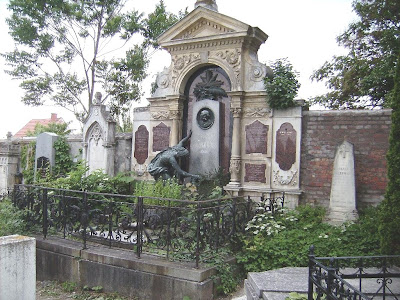Notice how beautifully cared for many of the tombs are. Unlike in America where the cemetery maintains what they euphemistically call "eternal care," in Europe families care for their own. I saw a grave today of a couple who died very old in the 1920s. The grave is meticulously landscaped, has a new rose bush and not a weed in sight. The vast majority of tombs and graves are equally well-maintained.

Note the skull and crossbones. We've seen that on
many of the tombs and don't know the significance.
It could just be death, but in the Middle Ages it
meant death by pestilence.





This man's name is Hungarian, and although I don't speak the
language, there were enough dates to show that he was a soldier.


The inscription has weathered a lot, but I could tell by
some dates that this couple had lost a child. This one
touched my heart.



This tomb carries the names of three brothers who all died
in 1919. They were all born in the mid to late 1890s so they
died in their mid twenties. There was considerable unrest
in the area after World War I to decide if Sopron would be
part of Austria or Hungary. The brothers could have been
killed during the unrest, or perhaps they died in the flu
pandemic. The star on the tomb suggests to me that they
were in the army during World War I.

The next five pictures are from the cemetery here in Siegendorf.





The rest of the pictures are from the cemetery in Klingenbach.






Maybe the three brothers died of the influenza pandemic? This flu killt especially younger adilts.
ReplyDeleteFrom 1918 to 1920 the Spanish flu (infuenza) swept over the world and killed more people than WWI.
http://en.wikipedia.org/wiki/1918_flu_pandemic
I think the flu pandemic is the most likely explanation.
ReplyDelete